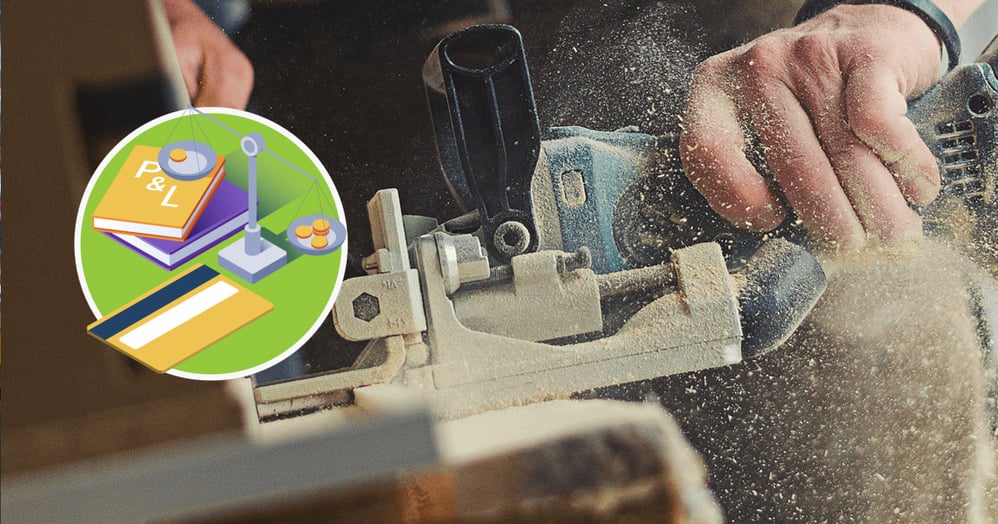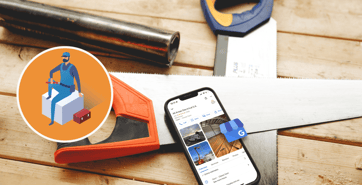Hire Purchase vs Leasing Trade Business Assets
by Team Tradify, June 8, 2021

Table of Contents
Forking out large amounts of money when starting up a trade business is tough. So is covering the cost of replacing expensive assets when the unexpected happens. If you don’t have the cash on hand for necessary tools and assets, other options can ease the pressure – and be kinder on your cash flow. In this article, we’ll look at the two most popular alternatives to paying for something outright: hire purchase and leasing.
Sometimes it makes sense to rent assets rather than physically own them. Certain items may cost a lot in ongoing maintenance and repair, and you might not even use them that often. Let’s look at the options and how these could work for your trade business.
Interested in getting a better handle on your business's finances? Download our free Cashflow Forecast Template and make sure you know your numbers!
Jump ahead:
- 1. What is hire purchase?
- 2. What is leasing?
- 3. Considering hire purchase vs leasing
- 4. Budgeting for new equipment
- 5. Where can I find the tools for lease or hire purchase?
- 6. Revolving credit facilities
- 7. Business loans
- 8. Consider the future of your business
It’s all about the tools
Before we get into the financial details, it’s important to note that most lenders offering equipment finance are focused on ‘hard assets’. That means you can finance things like vans and machinery, but not ‘soft assets’ like power tools or computers.
Different lenders will categorise assets differently, but there are a few general rules that the asset will need to satisfy:
- Central to your business’s activities
- Not too vulnerable to depreciation
- Clear resale value
1. What is hire purchase?
If you know you eventually want to own something, but don’t have the capital to buy it immediately, hire purchase (also known as credit sale) is one option. With hire purchase, it’s treated like you own the asset as soon as you sign the agreement, but you pay it off in instalments. Since the asset becomes your responsibility from the outset, you’re liable for any maintenance, insurance and servicing – just like buying something outright.
While hire purchase allows you to get what you want without the huge initial outlay, the downside is that you’ll end up paying more overall. You’ll most likely get charged a set-up fee, deposit, tax, and interest along the way. If you can’t keep up with your payments, the asset may be repossessed.
Hire purchase might be the right choice for you if you want to purchase expensive equipment for the long term, but don’t want to commit a large cash sum up front.
2. What is leasing?
Think of leasing like borrowing with a contract. You never actually own the asset and you’re often not responsible for things like maintenance and servicing. As with hire purchase, you don’t have to shell out a huge amount of cash upfront, so it can be a great option when buying a bigger asset is out of the question. This form of funding may also be called an operating lease.
The main attraction of leasing is the ability to continually upgrade your trade business assets (things like specialised equipment, tools, or vehicles) when your leases come to an end. Constantly investing in all the latest equipment isn’t viable for most tradespeople, so leasing allows you to keep up with new technology in a more affordable way.
Cordless power tools are a great example – they’ve completely changed the way tradespeople work. No more hustling for long extension cables or searching for power supplies, which leads to better productivity. Leasing can also act as a ‘try before you buy’ (or commit to hire purchase). You can try out new cutting-edge equipment to see if it’s something you’d like to invest in long-term.
3. Considering hire purchase vs leasing
There are pros and cons to both hire purchase and leasing, so it depends on your individual circumstances and needs.
Here are a few things to consider:
Frequency of use
If it’s a specialised piece of equipment that you’ll pull out once in a blue moon, there’s no real point in buying it outright or through hire purchase. Leasing or hiring for a short period makes more sense.
Lifespan
Think about whether the item will be outdated soon. Hire purchase doesn’t make sense for something that’s bordering on obsolete, so a short-term lease could be the best way to go.
Additional costs
Consider ongoing costs like repair and maintenance – will you have funds to cover these? With hire purchase, you’ll need to pay for any maintenance that crops up (it’s inevitable for bigger assets like work vans). If you’re leasing, these costs are often already accounted for in your regular payments. Knowing how much cash you have to play with will help. Here are some tips and tricks to help you figure out your break-even point.
Beware of any restrictions
If you’re leasing, there are sometimes restrictions on the amount of use (like mileage for vehicles). Consider carefully how you’re going to use an asset before committing to a lease or hire purchase.
The tax equation
From a tax perspective, hire purchase and leased assets behave differently. Leased assets are viewed as an operating cost and are typically tax-deductible, whereas hire purchase items appear as an asset on your balance sheet. Talk to your accountant about the differences between business expenses to help you make the best decision for your business.
Learn more about business expense claims in the UK or tax deductions in Australia.
4. Budgeting for new equipment
You know you’ll need tools to do your job, so you should be budgeting for new or replacement equipment. Putting aside a regular amount of money each month or quarter will take the sting out of hire purchase or lease payments. Check out our blog on sales forecasting for some helpful tips, and make sure your charge-out rate is on track to cover your fixed costs.
5. Where can I find the tools for lease or hire purchase?
Many trade equipment suppliers partner with finance providers or offer the option of leasing. Here are a few local sources to get you started, but be sure to shop around for the best deals.
- UK – Tool Stop or Jewson
- AU – Tools Warehouse or Kennards
- NZ – The Tool Shed or Kennards
- USA – Teng Tools or United Rentals
6. Revolving credit facilities
Another way of getting new equipment without restraining your cash flow is by using a revolving credit facility. It is similar to a business overdraft, which means you’ll have a pre-approved credit limit which you can dip into whenever you need additional funds. This type of working capital finance can be a useful safety net for your business if you’re thinking about buying new equipment.
Revolving credit facilities are a ‘rolling agreement’ rather than a business loan. The lender will usually specify how long after drawing down funds you’ll have to make repayments, and you normally only pay interest on what’s outstanding.
All this makes revolving credit facilities a very flexible solution, and a good alternative to business overdrafts with your high street bank, which may be more difficult to get. However, bear in mind that the credit limit available might not be high enough for the business equipment you need.
7. Business loans
If your business needs large machinery that would exceed the credit limit of your revolving credit facility or an overdraft, you could consider a business loan. There are two main forms of business loans — unsecured and secured.
Unsecured business loans
Unsecured business loans don’t require any collateral, which means your business’s financial position needs to be strong. Most lenders will want you to give a personal guarantee too, which means you’ll be personally responsible for the loan if your business defaults on payments.
With unsecured business loans, you’ll usually have a lower loan amount and interest rates tend to be higher because the lender carries most of the risk.
Secured business loans
With secured business loans, you can use assets that your business already owns to secure the loan. The amount you can borrow is based on the value of the existing assets — but bear in mind that this means the lender can seize your assets if your business can’t pay.
Secured business loans can take longer to get approved because of due diligence processes like valuations.
8. Consider the future of your business
As with many business decisions, there isn’t just one right way of doing things. The decision to purchase outright, lease or hire purchase will vary for each business asset, and there are plenty of factors you’ll need to consider before deciding.
If you’re not sure, leasing an asset short-term is a great way to buy yourself some time to decide what’s right for your business. And remember, it’s important to consider not only what you need today to get the job done, but also what you’ll need to grow your trade business. That’s where having a solid business plan will come in handy.
Looking for tools to run your trade business better and more efficiently? Download Tradify for a free 14-day trial or see the app in action during one of our live walkthrough webinars.
Related articles

How To Set Up a Google Business Profile (for Trade Businesses)

Aussie Electrician Reduces Admin Time by 95%

Squeaky Clean Scheduling for Pro Carpet Cleaning
Give Tradify a go for free!
Save 10+ hours/week on business admin with the highest-rated job management software for tradespeople.
With free one-on-one training and phone support, it's never been easier to get started.




